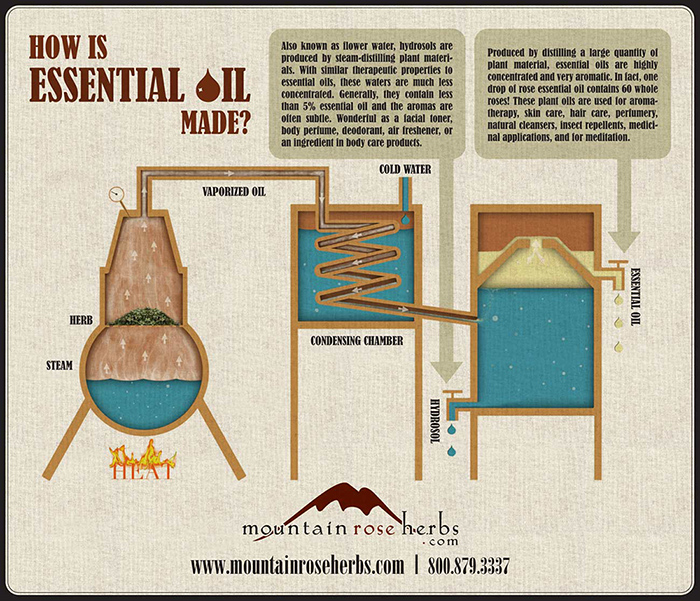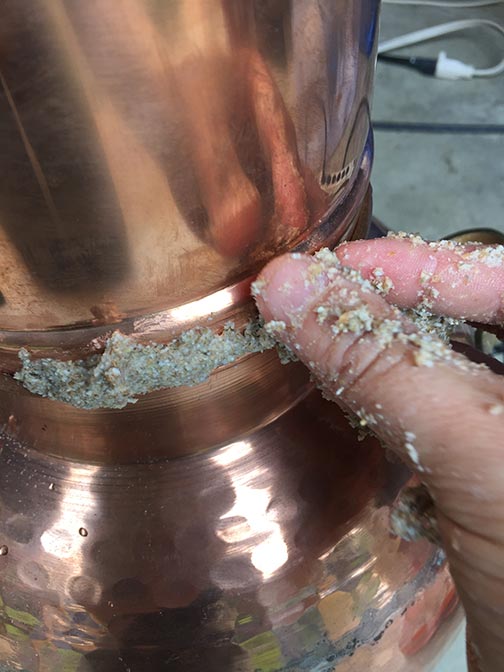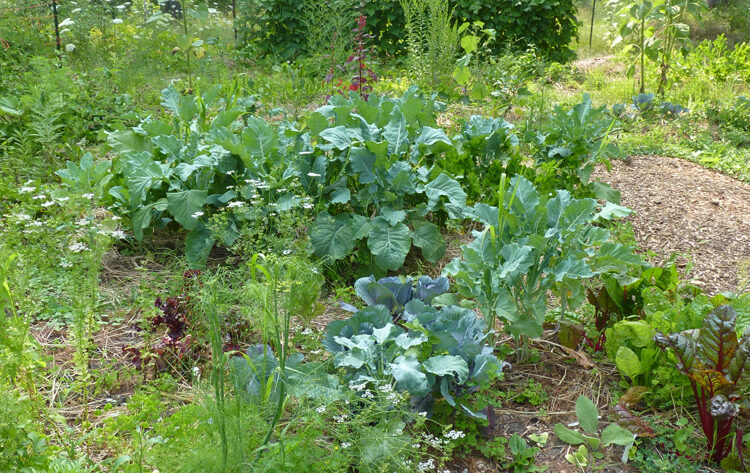Nature can provide tremendous wisdom and healing, especially when we work with our local ecosystems and ecologies. One of the most powerful ways of working healing with nature, I believe, is to combine the innate healing properties of plants with your own various kinds of medicinal preparations. The plants and trees offer the raw material and your hands and tools shape that material into something that heals the body, mind, and/or spirit. Working to transform tree and plant matter through alchemical processes into medicine–and then taking that medicine–can be an incredibly powerful way of establishing deep relationships not only with the living earth but with the trees themselves. Today, I want to talk about a particular kind of medicine known as a “hydrosol” and talk about how you might make your own with plant and tree material. This is especially beneficial for today as many of us are thinking about planning our year, what we will be planting and growing in containers and in gardens, and so forth.

Alchemy in the Inner and Outer Worlds
Alchemy is the ancient art of matter transformation. Alchemists worked to turn base metals into gold, to render the philosopher’s stone for that purpose. Alchemists also worked with plants through spagyrics, the practice of plant alchemy. It was believed by the alchemists that the process of alchemy, as the material moved through the black, red, and white phases, didn’t just happen on the physical plane, but rather facilitated transformations of mind, body, and soul. I, like most folks of this time period, have never done anything with metal alchemical work (it is highly toxic). But for many years, I’ve been fascinated by spagyrics, and have made a number of preparations using those techniques. (For good reading on the subject, I suggest Mark Stavish’s Path of Alchemy as an introduction). Because Alchemy is an inner and outer process, there is a whole movement of “inner alchemy” or “spiritual alchemy” work, work that can be can be used for inner transformations. The thing about any alchemical process is this: matter has to be broken down with fire and heat in order to be reformed in a more pure manner.
I’ve been thinking a lot about the work we might do with trees and alchemy and have been experimenting in various ways in that direction. Basic spagyric preparations (which are detailed in Mark Stavish’s excellent work) combine macerating plant matter in high-proof alcohol (that is, soaking it for a period of time) and going through a process of refinement where the material that was macerated is burned and the ash is further refined. Eventually, the refined materials are combined for a highly potent medicine.
I think there are other kinds of work you can do with plants and tree matter that are a little less direct. On the most passive side that requires little tools, preparation, or time, a simple flower essence (where a bowl of spring water is held up to a leaf or flower of the plant, imbuing that plant energetically) is a good first step. Somewhere in the middle, requiring some preparation, tools, and time, we have the hydrosol and the creation of essential oil. On the far side, requiring much preparation and time, we have the full spagyric plant preparation.
Hydrosols and Essential Oils
Hydrosols are also known as “floral waters” although they can be made of much more than just flowers. They are produced by a simple distillation process. You can purchase fancy equipment (often known as an Alembic or Still) to do this or you can do it with stuff you likely have already in your kitchen (I am going to offer information on both approaches.) I used the simple stovetop approach with kitchen materials for many years before, using about $10 worth of materials from the thrift store for very small batches. Then, last year, I finally invested in a medium-sized copper alembic to do more advanced preparations.
The process of making a hydrosol, which I’ll detail with photographs below, involves gathering fresh plant material that is aromatic in nature. You will need a lot of plant matter – usually several pounds. It involves heating the material up to create steam, cooling that steam and condensing it back into a liquid form that is medicinal and relatively shelf-stable).
Hydrosols are sacred medicine in their own right, although they are often seen as “by-products” of the essential oil distillation process. When you heat up plant matter that has high amounts of volatile oils, those oils also come out through the distillation process and sit on the top of the hydrosol. Most people working on this process at home, particularly with sacred trees, may not produce enough oil to make it worth their while, although some plants, like lavender or goldenrod, certainly can do so, especially if you do several batches of distillation.

Choosing Your Material
Harvest your plant material with reverence and respect. Hydrosols and distillation take a good deal of plant material (particularly if you are using an Alembic and doing a higher amount of distillation). Keep this in mind as you are planning for the garden this year! Plant material should be safe to consume or at least put on the body. Despite my positive relationship with Poison Ivy, I would not, under any circumstances do a steam distillation of it!
Any plant or tree that is typically used in herbal practice and that has a scent would be a good choice. Common kitchen herbs are often used such as:
- Sage
- Rosemary
- Lavender
- Rose(petals)
- Mints
- Thyme
- Oregano
- Monarda/bee balm
- Scented geranium
In terms of trees, the leaves or needles would work. Ones I’ve experimented with include:
- Blue Spruce (needles)
- White Pine (needles)
- Eastern Hemlock (needles)
- Black Birch (budding branches)
- Sassafras (root)
Harvesting the Herbs/Plants/Branches
Harvest your material on a sunny day when it is not raining. The rain, particularly for flowers or aromatic leaves, can dilute the plant oils and overall results. Harvest the plant matter in abundant areas or grow it yourself to ensure that you are not taking too much from the plant matter. Generally speaking, if the plant is rare, doing a tincture is probably the best way to use that plant’s energy because it is the most efficient. If the plant is very abundant, a steam distillation would be a good choice.
The timing also matters–plants have different levels of aromatic oils at different times of year. If I was doing a black birch preparation, I would do this in the early spring due to the amount of sweet oil in the birch branches that time (due to the flowing of sap). Other plants, like the conifers, don’t matter as much. Flowers and herbs should be harvested at their peak–so when the lavender is in flower, for example, but before it goes to seed.

A friend and I went out and harvested a number of plants to fire up the copper alembic. We did four distillations, two of herbs (goldenrod and sweet clover) and two of trees (eastern hemlock and blue spruce). We experimented with different kinds of approaches to distillation.

Distillation Process
Now I am going to walk step by step through the distillation process.
Preparing the Alembic and the Plant Matter
Once we were home, we removed large stem material and did our best to crush up the hemlock needles. We had not done this with the blue spruce (instead, placing whole small branches in the alembic) and that proved to give us very little essential oil, but certainly, a nice hydrosol. Breaking up the hemlock material took more work, but we believe, it was worth it as we had a better preparation.

After we soaked the needles, we added fresh spring water (harvested at my local sacred spring, Heffley Spring) for the distillation. If you can’t get access to freshwater, I would consider using distilled water. The point is this: the process is very potent, and I certainly wouldn’t want any human-added chemicals, like chlorine, in my distillation.

My alembic also has an addition column where you can cram more plant matter in and the top that also takes plant matter. So I did this–so both the base and column are filled with plant matter (this photo shows Goldenrod), and the base is also filled with water. That gives you a lot of plant matter at once to steam distill–probably 10x what I used with my other method.

Sealing the Alembic
In the traditional method, Rye flour is used to seal up the alembic prior to steaming it. If you have severe allergies to gluten, I would suggest sticky rice flour or tapioca flour in place of rye. I haven’t tried this, but I think it would work. First, you mix a big batch of the Rye flour up. It looks a lot like sticky bread dough. I didn’t measure, just added enough water till I got a nice paste.

Then you basically smear it into the cracks and crevices of the entire alembic to hold it together. The idea is to seal it up so that as it starts to steam, it doesn’t leak steam anywhere.

The flour is a fun yet messy job.

Distillation
Distillation works with the heating up of the plant matter and water to create steam then cooling it down quickly for condensation. That’s the entire process. So you will need something to heat it up (I used a small outdoor burner) and you will need something to cool it down (I used lines with a small submersible fish tank pump and ice cold water).

I forgot to take a photo of the pump part of the system. The condenser unit has two cooper pipes sticking out of it–the top one flows water in and the bottom one pulls water out. You can keep the system cold if you flow cold water into it. Online, some people just use this from their tap, if they have a spring or well, the water is cold enough if you keep flowing it through. I didn’t have this, so instead, I used several bags of ice and a cooler. I placed the submersible pump at the bottom of the cooler and then ran the tubing through it and into the condenser. I used a little clamp to regulate the pressure of the water (so it would stay level, which required some work).
I found that the unit took about 30 minutes to heat up and about 45 minutes to actually start condensing the steam. I let it run for two or so hours until the water no longer looked cloudy when it was coming out of the condenser unit.

This final water has both your essential oil and the distillation in it. You can purchase a fancy oil separator (which I didn’t have when I did this) but I used a different method. In my case, the only plant that produced enough essential oil to really take off the top was goldenrod. To do this, I simply poured it all into a mason jar and then froze the whole thing. The hydrosol freezes but the oil does not. I then pulled it out of the freezer and used a pipette to pull the oil off the top of the jar, then unfroze the hydrosol and put it in neat little spritzer bottles.
Conclusion
Since doing this last fall, I have shared these hydrosols with many friends in the druid community. They remark on their potency–the spruce gives an incredible lift me up, the white pine brings peace, and the hemlock brings stability and space (mental space/clarity, is the way one person described it). In truth, the goldenrod got a little skunky/funky but did produce a nice oil, so I’m not sure I’ll do that one again (and I didn’t give that one away!).
Creating tree hydrosols and essential oils represents a unique and beautiful way to connect with the potent medicine of the trees and work with them for healing and transformation. What seems like an intimidating process is actually a very simple one: refining potent medicine through the application of fire, water, and ice. The practice of alchemy, of course, isn’t just about producing a physical medicine–but rather, the refinement and work on the level of the soul. Alchemical preparations not only as medicine for the body, but medicine for the soul.
PS: After this post, I will be taking several weeks off of regular posting on this blog to do some travel. I look forward to returning later in June to my regular posting. Blessings!




Reblogged this on Paths I Walk.
Reblogged this on Blue Dragon Journal.
Wow! Great info..thank you!
Gosh, I loved this! Thanks so much <3 I was just beginning a batch of lemon hydrosol right before I read your article to use in my bug repellent. Ticks are a nightmare here already this year! Love love love that this is alchemy. Divine timing <3
Reblogged this on Rattiesforeverworldpresscom.
Thank you for the reblog!
So helpful! I find that plants I need often appear in attention getting numbers when, or before, I know I need them. This has happened multiple times, and I am very grateful.
We moved to our current property last December, so this spring all is new to us. Well, the place is just about blanketed 🥰 in Spring Beauty, which I love. I decided to make a flower essence and now have a Mother Essence.
We are on a well, so I used this water. However, I used it from the tea kettle as that was the best way I could think to “purify” it as it is softened hard water. At least it doesn’t have the hefty chemicals of city water.
My question is whether I can use the water from the faucet to add the seven drops. Is it best to boil that, too?
This is my first time making a FE, so I am trusting more to intent than procedural restrictions. After all, it wouldn’t have appeared if we didn’t need it, so I’m guessing it will likely be more forgiving than some site’s’ instructions might indicate. That’s why I used your instructions— they were the gentlest and kindest.
Thank you!
You are most welcome! 🙂
If you have a well or spring, I think your water is probably already pretty great and you can use it 🙂
[…] собой паровую дистилляцию ветвей гамамелиса. Ветви гамамелиса лучше всего перегонять весной (для этого можно […]
[…] паровую дистилляцию ветвей гамамелиса. Ветви гамамелиса лучше всего перегонять весной (для этого можно […]